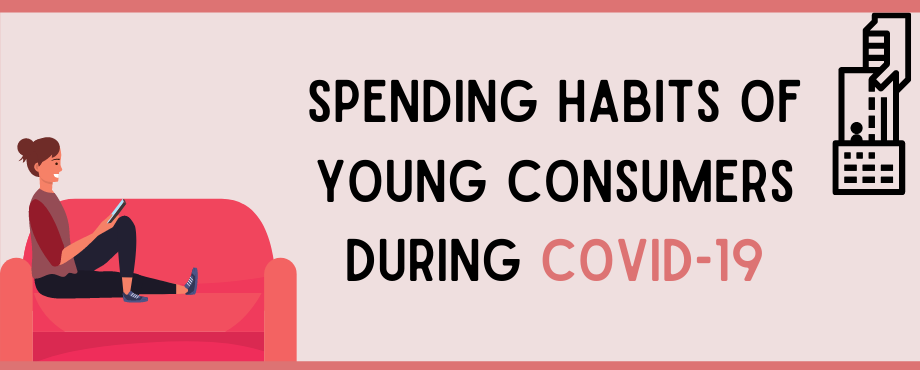Graphics by Nina Tagliabue
The COVID-19 pandemic has resulted in many changes in the daily lives of people from all around the world. Video streaming on social media platforms has shown people rushing into grocery stores and stocking up on canned food and toilet paper. Colleges have abruptly transferred to online education via Zoom and other video conferencing tools. About 16 million Americans have lost their jobs since the start of lockdowns across the country. Small businesses and local stores still struggle to keep their businesses afloat. The stock market has tanked around the world. Since the end is far from sight, the negative effects of COVID-19 will not likely change anytime soon. However, one thing is changing for sure: the spending habits of young consumers.
When the pandemic first hit the U.S., retail stores’ revenues went through the roof. However, as more time passed and the panic subsided, the retail industry started to struggle just like all the other industries. Consumers started saving more and spending less. Air travel, food deliveries, groceries, public transport, restaurants, and retail spending all went down drastically in the U.S..
Although everyone is trying to be more conscious of their spending during these unprecedented times, the groups that are trying to save the most are rather surprising. 40% of millenials and 41% of Gen Z are more likely to save than older generations according to a recent Business Insider article. Millenials and Gen Z make up about half of the current U.S. population combined and represent people born between 1981 to 1995 and 1995 to 2015. These groups lived through the recovery period of the 2008 recession, which changed their spending habits greatly. They are less likely to take risks while spending and are more focused on saving. Looking at the global economies, another global recession seems likely if the virus continues to spread. Therefore, as a precaution, Millenials and Gen Z spenders started buying less non-essential items. Since everyone is staying at home, there is no need to buy new sundresses and sandals for summer parties or plane tickets to travel to tourist sites. These groups’ spending in the service industry declined greatly as well. The majority of consumers are either Millennials or Gen Z, and these groups tend to stay at home more. Therefore, many restaurants, bars, night clubs, hair and nail salons are financially struggling due to the lack of customers.
On the bright side, Millenial and Gen Z spenders are looking for alternative ways to purchase goods. Due to these new spending trends, some companies’ revenues are increasing rapidly and are looking to hire more people during the pandemic. One such case is Amazon. Amazon is hiring 100,000 more people for deliveries as they can not keep up with the high demand from consumers who are staying home. Despite what government officials say, younger people in the U.S. are more willing to stay at home more for their own and loved ones’ safety. However this group is not used to sitting at home all day. Therefore, there is also an increased demand in baking supplies, sports goods, puzzles, and other items that will keep them sane until it is safe to go outside again. These items can easily be purchased from online retail stores and are rather cheap, which makes them very appealing to consumers. One downside of buying everything online is that small businesses don’t have the infrastructure to deliver to everyone’s doorstep. Thus, many of the already-struggling small businesses are likely to close their doors for good during this pandemic.
Consequently, while many industries have taken a hit due to restrictions from the pandemic, some industries have benefited from it. However, the general spending tendency of young consumers seems to be declining, which will have negative effects on both the global and national economies once the pandemic ends. Whether these changes in the spending habits of younger consumers are temporary or permanent will only be clear after the pandemic clears.
Take-Home Points
COVID-19 affected our lives in many different ways. However, it mostly impacted our shopping habits as we are not able to go out freely. This article sheds a light on consumer behaviour during the pandemic and how quarantine affected small and large businesses across the country.


Thanks so much for giving everyone an exceptionally pleasant opportunity to discover important secrets from this website. It is usually very pleasing plus packed with a lot of fun for me and my office peers to visit your blog at the very least 3 times weekly to read the newest issues you have got. And definitely, I am just certainly amazed concerning the attractive creative concepts you serve. Certain 2 areas in this article are basically the most effective we have all ever had.
One more issue is that video games are usually serious in nature with the key focus on learning rather than leisure. Although, there’s an entertainment feature to keep your children engaged, each and every game is often designed to work on a specific expertise or curriculum, such as numbers or research. Thanks for your post.
I’ve been browsing online more than 3 hours nowadays, but I by no means found any interesting article like yours. It抯 pretty price sufficient for me. In my view, if all web owners and bloggers made good content as you probably did, the net will probably be much more useful than ever before.